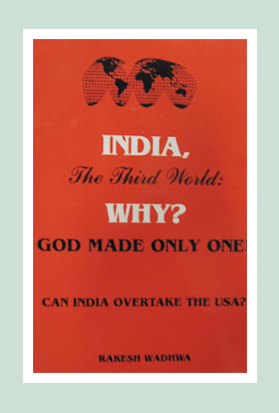When Government Inaction Cripples Economic Activity
It is a known fact that demand and supply decide the direction of a free market economy. However, it is the government that creates an atmosphere where market forces can operate without any fear for their investment.
Can India Ever Progress?
“Dinesh Trivedi’s budget has caused a political storm, after…Trinamool Congress asked him to withdraw the hike or quit…The Trinamool Congress, termed across-the-board passenger fare hikes as a ‘hostile act’.”– Economic Times, March 15, 2012
Will a Laissez-Faire System Boost Economic Growth?
Which kind of economy would you vote for – a laissez-faire market or a planned economy? My vote is for free markets.
Can Casinos Boost the Economic Growth of Our Nation?
Sri Lanka plans to introduce new laws this year to attract investments from casinos and hotel chains abroad. While Sri Lanka already has a thriving local casino industry, the government believes that laws permitting foreign investment in gaming will stabilize the sector
Trade and Prosperity: Where Does India Stand?
Economic Growth and prosperity have always been measured by the values and volumes of international trade. Both exports and imports are critical to economic development and prosperity. Exports bring in the much-needed foreign exchange and earnings into
Is India Truly Shining?
Is India doing well? This question is often asked, as to which the answer typically is that India is not merely doing well, it is in fact shining. India is the fourth largest economy in the world in terms of GDP. She is behind only the US, China
Is India shining?
On December 6, 2004, this column carried my article ‘copy China, not India’. A friend, Ramesh, objected. ‘Isn’t India doing well?’ he asked.
India is not merely doing well, it is shining. India has never done better: the stock market is at its peak; foreigners are investing in amounts never seen before; trade is at its all time high; earnings from outsourcing and software exports are the world’s envy; the treasury is bulging with reserves of 125 billion dollars; and more.
The signs of prosperity are everywhere. There are more cars, cell phones, houses, flyovers, cinema halls, shopping malls, foreign goods, and TV channels.
Delhi is beginning to look more like the rich cities of the West than the Delhi I was used to. Clothes from Nike, Levis, Benetton, Hugo Boss, and Van Heusen vie for attention. McDonald, KFC, TGIF, and Dominos offer the most popular of the world’s fast foods. Wines and cheeses from all over the world have finally arrived. Honda, GM, Hyundai, Suzuki, Ford, and Mercedes cars are seen all over the city. No international hotel chain worth its name wants to be left without a presence: there is the Hyatt, Marriott, Holiday Inn, Intercontinental, Hilton, Meridian, Crowne Plaza, and Radisson.
Yes, India has come a long way since Manmohan Singh first liberalized India’s economy in the 90’s. What could not be done with strict government controls in the 45 years of the leftist-socialist Nehru-Indira-Rajiv period, has been achieved in under 14 years of limited market reforms.
Everyone is benefiting. In fact there is no way to keep the advantages limited to a few. What is happening in India is not unique. Goods which start out as luxuries for a handful eventually become everyday necessities for a majority.
Millions of Indians are now hooked to their cell phones. These now exceed the number of landlines in most States. Phones, which were available to eight million people when the government operated the network just a decade ago, are now owned by 90 million. In the next 2-3 years cell phones will be held by 200 to 300 million subscribers.
Under state ownership people could view only what India’s government TV channels wanted. Not any longer. Private telecasting companies have spelt the end of programmes showing Indians how to grow potatoes. Dozens of channels now compete for ‘eyeballs’ with never ending creativity.
Hardly anyone flew during the days of Indira Gandhi, 50 million people will do so in 2005. Outbound tourism from India is set to break all records. Every major country is wooing the India traveler. With the end of monopoly of Indian Airlines and Air India, private airlines, particularly low cost Deccan Air, are taking ‘flying’ to the masses.
Those who owned the Fiat and Ambassador cars earlier now ride in Mercedes, Fords, and Hondas. Those who rode scooters have Maruties, and those who had bicycles have scooters and motorcycles. Those who walked have cycles, or use the new underground trains.
It is not Delhi alone, but other cities also which are being metamorphosed. Benefits are spreading, rural areas are doing even better. Most companies are reporting that the highest growth in sales of their products is being witnessed, not in big cities but, in smaller towns and villages.
So where is the problem? Why did I ask Nepal to copy China not India? It is just that India can do better. It can shine ever more brightly by letting markets, which are doing so well with the half chance that they got, take care of education, employment, and development too. India can overtake China only if it junks wasteful populist measures and reduces govt. intervention in the economy.
India needs to stop collecting taxes in the name of education. It needs to shelve plans to spend 60,000 crore rupees in guaranteeing jobs to the poor. Labour laws need to be rescinded, reservation for small industries and for jobs needs to end. Currency needs to be convertible and foreign investment easier. Customs and excise duties need elimination.
India’s growth will then go from 6-8% which is great, right into the stuff of legends perhaps touching 20%. However, until such policy changes happen it will be China which will remain ahead.
The Himalyan Times
 Rakesh Wadhwa. Ever since, I was a school boy, I knew India was on the wrong path. Socialism was just not what we needed to get ahead. Government controlled our travel; government controlled our ability to buy and sell; and government controlled our freedom to move our money. My life has focused on the inherent rights people have. When I was in college, I never understood, what the governments meant by their "socialistic attitude". If people are free to buy, sell and move their capital themselves without any restrictions by state, then the welfare of people is inevitable & hence the countries they live in will become wealthy. The government has no right whatsoever, to point a finger at me or my business. I am not a revolutionary. I just want to light up my cigarette and not get nagged about it. I believe in non-interfering attitude to attain more.
Rakesh Wadhwa. Ever since, I was a school boy, I knew India was on the wrong path. Socialism was just not what we needed to get ahead. Government controlled our travel; government controlled our ability to buy and sell; and government controlled our freedom to move our money. My life has focused on the inherent rights people have. When I was in college, I never understood, what the governments meant by their "socialistic attitude". If people are free to buy, sell and move their capital themselves without any restrictions by state, then the welfare of people is inevitable & hence the countries they live in will become wealthy. The government has no right whatsoever, to point a finger at me or my business. I am not a revolutionary. I just want to light up my cigarette and not get nagged about it. I believe in non-interfering attitude to attain more. 
 The Bastiat Award is a journalism award, given annually by the International Policy Network, London. Bastiat Prize entries are judged on intellectual content, the persuasiveness of the language used and the type of publication in which they appear. Rakesh Wadhwa won the 3rd prize (a cash award of $1,000 and a candlestick), in 2006.
The Bastiat Award is a journalism award, given annually by the International Policy Network, London. Bastiat Prize entries are judged on intellectual content, the persuasiveness of the language used and the type of publication in which they appear. Rakesh Wadhwa won the 3rd prize (a cash award of $1,000 and a candlestick), in 2006.
What the readers are saying…